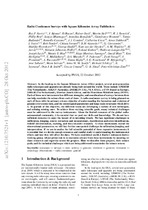Radio continuum surveys with square kilometre array pathfinders
Date
2013Author
Norris, Ray P.
Afonso, J.
Bacon, David
Cress, Catherine
Metadata
Show full item recordAbstract
In the lead-up to the Square Kilometre Array (SKA) project, several next-generation
radio telescopes and upgrades are already being built around the world. These include APERTIF
(The Netherlands), ASKAP (Australia), eMERLIN (UK), VLA (USA), e-EVN (based in Europe),
LOFAR (The Netherlands), Meerkat (South Africa), and the MurchisonWidefield Array (MWA).
Each of these new instruments has different strengths, and coordination of surveys between them
can help maximise the science from each of them. A radio continuum survey is being planned on
each of them with the primary science objective of understanding the formation and evolution of
galaxies over cosmic time, and the cosmological parameters and large-scale structures which drive
it. In pursuit of this objective, the different teams are developing a variety of new techniques,
and refining existing ones. To achieve these exciting scientific goals, many technical challenges
must be addressed by the survey instruments. Given the limited resources of the global radioastronomical
community, it is essential that we pool our skills and knowledge. We do not have
sufficient resources to enjoy the luxury of re-inventing wheels. We face significant challenges in
calibration, imaging, source extraction and measurement, classification and cross-identification,
redshift determination, stacking, and data-intensive research. As these instruments extend the
observational parameters, we will face further unexpected challenges in calibration, imaging, and
interpretation. If we are to realise the full scientific potential of these expensive instruments, it
is essential that we devote enough resources and careful study to understanding the instrumental
effects and how they will affect the data. We have established an SKA Radio Continuum Survey
working group, whose prime role is to maximise science from these instruments by ensuring we
share resources and expertise across the projects. Here we describe these projects, their science
goals, and the technical challenges which are being addressed to maximise the science return.

